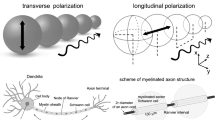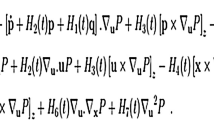Conclusions
-
1.
An extracellular electrical current creates on the cell membrane an induced potential, the magnitude of which increases with increasing length of the cell in the field.
-
2.
The effective length of the cell in the direction of the field is determined by the ratio of the resistances of the soma and of the processes directed along the field.
-
3.
The cell process contributes toward creating considerable shifts of the membrane potential on the cell soma for a current density of 0.06–1.1 mA/cm2.
Similar content being viewed by others
Literature cited
P. M. Balaban, O. A. Maksimova, I. S. Zakharov, and V. N. Mats, “Electrophysiological characterization of identified nerve cells inHelix lucorum.,” Zh. Evol. Biokhim. Fiziol.,17, No. 4, 366 (1981).
V. N. Ierusalimskii, P. M. Balaban, and V. M. Shtemler, “Effect of a low-frequency electric current on the activity of snail neurons for extracellular influence,” in: The Biological Effect of Electromagnetic Fields [in Russian], Pushchino (1982), p. 93.
E. R. Kandel, Cellular Basis of Behavior: An Introduction to Behavioral Neurobiology, W. H. Freeman (1976).
I. S. Magura, E. V. Grobova, and I. Z. Zamekhovskii, “Electrical characteristics of giant neurons of mollusks,” Neirofiziologiya,4, No. 6, 651 (1972).
D. A. Sakharov, Genealogy of the Neuron [in Russian], Nauka, Moscow (1974).
U. R. Éidi, “Frequency and energy windows for the effect of weak electromagnetic fields on living tissue,” Tr. Inst. Inzh. Elektrotekh. Radioelektron.,68, No. 1, 140 (1980).
P. M. Balaban, “A system of command neurons in snail's escape behavior,” Acta Neurobiol. Exp.,39, No. 2, 97 (1979).
J. Bernhardt and H. Pauly, “On the generation of potential differences across the membranes of ellipsoidal cells in an alternating electrical field,” Biophysics,10, No. 14, 89 (1973).
L. J. Bindman, O. J. C. Lippold, and J. W. T. Redfearn, “The action of brief polarizing currents on the cerebral cortex of the rat (1) during current flow and (2) in the production of long-lasting after-effects,” J. Physiol. (Engl.),172, No. 3, 369 (1964).
J. Bures, “Ontogenetic development of steady potential differences in cerebral cortex in animals,” EEG Clin. Neurophysiol.,9, No. 1, 121 (1957).
S. B. Kater and R. D. Hadley, “Intracellular staining combined with video fluorescence microscopy for viewing living identified neurons,” in: Cytochemical Methods in Neuroanatomy, Alan R. Liss, Inc., New York (1982), p. 441.
J. G. R. Jeffreys, “Influence of electric fields on the excitability of granule cells in guinea-pig hippocampal slices,” J. Physiol. (Engl.),319, No. 2, 143 (1981).
D. P. Purpura, “Mechanisms of propagation: intracellular studies,” in: Basic Mechanisms of the Epilepsies, Churchill, London (1969), p. 441.
C. A. Terzuolo and T. H. Bullock, “Measurement of imposed voltage gradient adequate to modulate neuronal firing,” Proc. Natl. Acad. Sci. USA,42, No. 3, 687 (1956).
Author information
Authors and Affiliations
Additional information
Translated from Zhurnal Vysshei Nervnoi Deyatel'nosti imeni I. P. Pavlova, Vol. 36, No. 1, pp. 163–169, January–February, 1986.
Rights and permissions
About this article
Cite this article
Ierusalimskii, V.N., Balaban, P.M. Magnitude of potential induced in a mollusk nerve cell in a low-frequency electric field. Neurosci Behav Physiol 17, 125–130 (1987). https://doi.org/10.1007/BF01184902
Received:
Issue Date:
DOI: https://doi.org/10.1007/BF01184902




